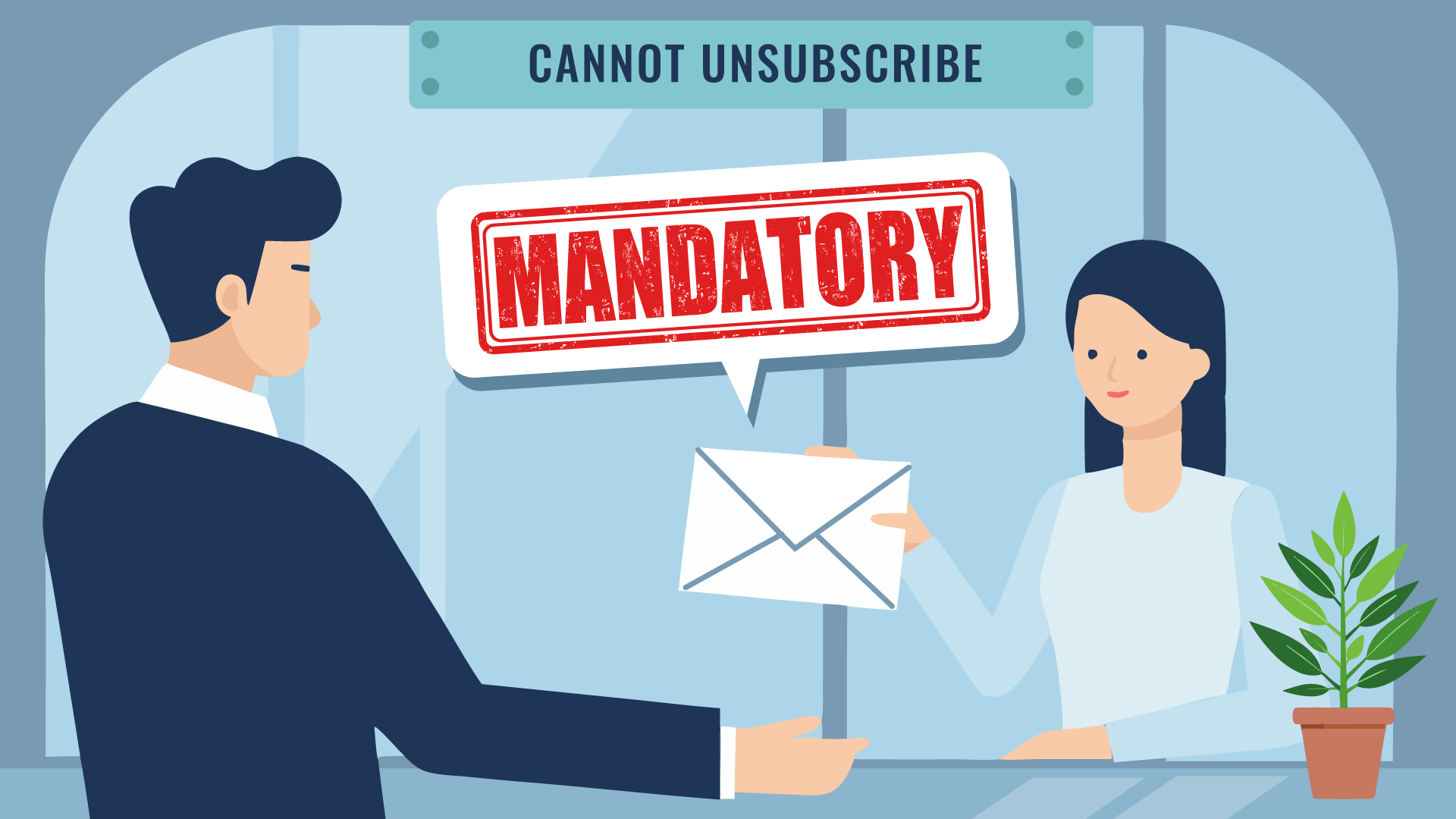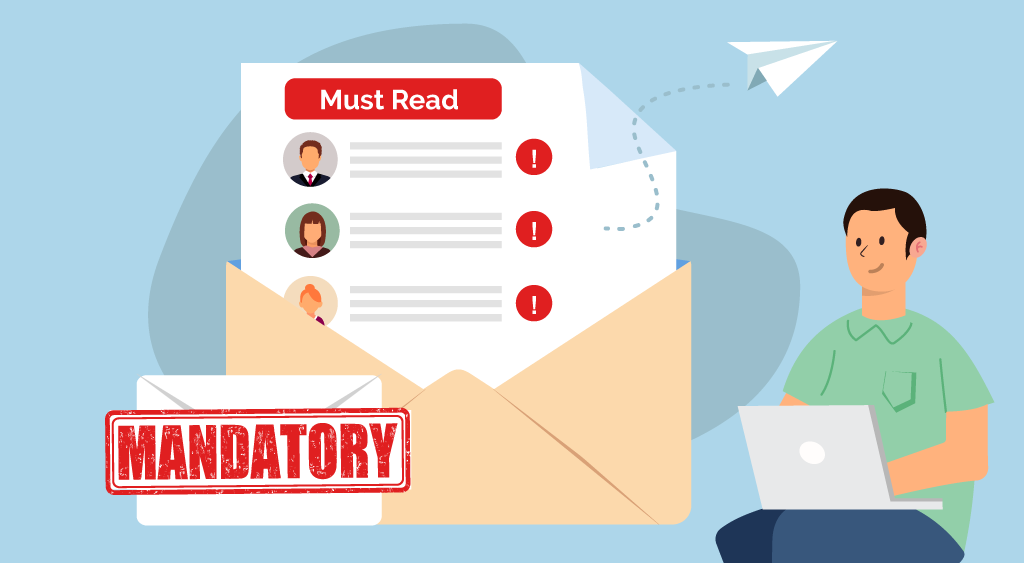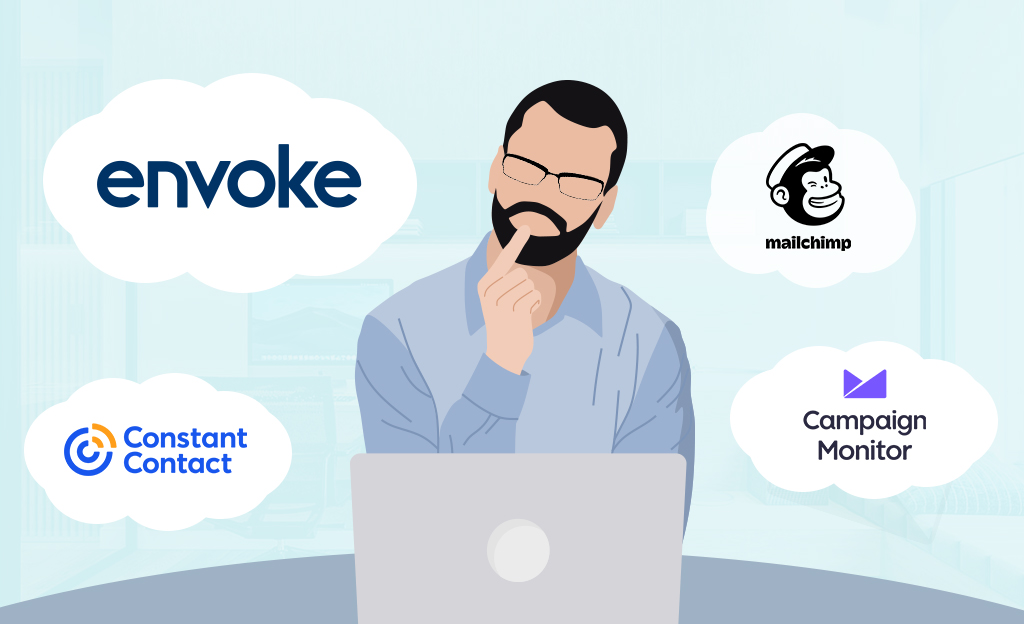Sometimes communications professionals have to email unsubscribed contacts.
If you work for a university, a municipality, or a public sector organization, this task will be familiar to you. Your organization (and others like regulators and associations) may be bound by a contractual, regulatory, or other legal obligation to email all stakeholders essential information. Even unsubscribed contacts are often required to receive information about things like contract updates, health and safety information, or schedule changes.
These emails are essential. And mandatory. But that doesn’t mean they’re easy to send. Unless you use Envoke.
What You’ll Learn in This Blog:
- How Do You Email Unsubscribed Contacts?
- How Does Envoke’s Mandatory Messaging Work?
- Give Your Contacts Options
- Is it Legal to Send Email Without an Unsubscribe Link?
- What About CASL and CAN-SPAM Regulations?
- How Can I Send Messages to Unsubscribed Contacts With Mailchimp?
- How Can I Send Email to My Opt-Out List With Constant Contact?
- What Are Some Reasons To Send Mandatory Messages?
- Contacts Can Still Unsubscribe From Optional Content
- Key Benefits of Envoke for Communications Professionals
How Do You Email Unsubscribed Contacts?
If you are a customer of Envoke, the email marketing platform purpose-built for communicators, you can use our Mandatory Messaging feature to send emails to all contacts, even if they’ve unsubscribed from your optional content.
It’s unique, and it’s not something you’ll find at Mailchimp or Constant Contact.

How Does Envoke’s Mandatory Messaging Work?
It’s easy to get started using our Mandatory Messaging feature at Envoke.
1) Contact Envoke support to easily enable the Mandatory Messaging feature
Eligible organizations can set up the Mandatory Messaging feature by contacting the Envoke support team. Start a support chat anytime!
2) Designate desired contacts as recipients of Mandatory Messaging
Each contact in your account who is subject to your contractual or regulatory requirement to send mandatory emails is marked as a mandatory content recipient. This can be done individually as new contacts are added, or as a group edit function.
3) Provide the reason you need to email unsubscribed contacts
To use Mandatory Messaging, you need to explain the legal or contractual obligation that requires you to send emails to unsubscribes and link to a document or website that verifies your reason. This document might be your terms of service or the regulation that allows or requires you to send essential emails even to unsubscribed contacts.
4) Prevent spam with transparent communication
Your reason for sending mandatory messages and the link to your verification document are both included in the footer of every mandatory message you send. This promotes good transparent communication and reduces the likelihood that your contacts will report your message as spam.
5) Link to the Email Preferences page
The footer of every mandatory message also links to an Email Preferences page which allows your contacts to request removal from Mandatory Messaging. They cannot self-serve unsubscribe from this service and every request must be reviewed by an admin on your team. Eligible reasons for removal could include contacts moving outside of the jurisdiction or retiring from your organization.
FACT: The link to the Email Preferences page is critical. You can’t remove this link and you shouldn’t. Without it, your emails may be classified as spam by spam filters before they even arrive at inboxes.
6) Designate messages as mandatory
Once enabled, Mandatory Messaging is straightforward to use. A single click allows you to designate an email as mandatory in your Envoke settings. When a message is marked “mandatory,” every person on your contact list who is subject to your Mandatory Messaging regulation or contractual obligation, will receive it:
- Even if they are on your opt-out list and have unsubscribed from other optional content.
- Only contacts who are designated as mandatory message recipients can be sent mandatory emails.
Are you a communicator stuck using tools made for marketers? Try the email marketing platform purpose-built for communications professionals. Envoke offers a mandatory message setting for situations when legal or contractual obligation requires you to send emails that your contacts must receive, even if they’ve unsubscribed. Give Envoke a try!
Try Envoke today: Create a free trial account.
Email for communication, not lead generation.
- Includes ALL Envoke features.
- No credit card needed for trial.
- Free, unlimited support.
- Free coaching call with tech support (not sales).
Give your Contacts Options
All mandatory messages link to an Email Preferences page where contacts can request to be removed from Mandatory Messaging. Contacts cannot self-serve unsubscribe from mandatory emails, so every request must be reviewed by an admin in your organization to determine if their request is valid. Valid reasons for removal could include a contact moving out of the jurisdiction or retiring from an organization.
Opening a dialogue with your stakeholders provides them with choices, promotes great communication, and reduces the chances they’ll mark your emails as spam. Good news all around!
Is it Legal to Send Emails Without an Unsubscribe Link?
Yes, it’s perfectly legal for communicators to use Mandatory Messaging for sending essential, non-commercial emails from which their contacts cannot unsubscribe. To activate the feature, companies must demonstrate a contractual, regulatory, or other legal obligation to send these emails. They also need to share a document that verifies their reason.
The messages don’t contain an unsubscribe link, because contacts can’t unsubscribe from Mandatory Messaging as a self-serve option. But remember that every mandatory message contains a footer that explains why the contact is receiving mandatory messages and a link to the Email Preferences page where they can request to be removed from Mandatory Messaging if a valid reason is provided.
What about CASL and CAN-SPAM Regulations?
These regulations are important and help protect us from unwanted commercial emails. Mandatory Messaging is not commercial, so these emails are not governed by anti-spam regulations like CASL.
How Can I Send Messages to Unsubscribed Contacts with Mailchimp?
You can’t. Mailchimp is very clear about this:
“If you want to send a marketing email to someone, that person needs to have opted in to receive marketing or promotional emails from you. If they’re not subscribed to your email marketing, then you do not have permission to contact them for marketing purposes.” Mailchimp
This is a good policy. Mailchimp is made for marketers to send commercial email messages and it doesn’t want its customers to email unsubscribed contacts. Commercial email messages cannot and should not be sent to unsubscribed contacts. The only problem here is that many communications professionals are stuck using Mailchimp and are missing out on essential functionality they need to do their jobs.
How Can I Send Email to My Opt-Out List Using Constant Contact?
Any guesses?
That’s right.
You can’t.
“When contacts choose to stop receiving emails from you and opt out of your contact list, they’re marked in your account as “unsubscribed” and can no longer be sent emails.” Constant Contact
What Are Some Reasons to Send Mandatory Messages?
Institutions like universities, associations, regulators, healthcare, and public sector organizations have a duty to share mandatory information with their stakeholders, which sometimes means they must email unsubscribed contacts. Some examples include:
- Internal Announcements: Critical company updates for employees
- Safety Communications: Product recalls or urgent safety notices
- Public Alerts: Emergency notifications or vital public health information
- Educational Updates: Program changes or schedule adjustments for students
- Terms of Service: Important modifications to user agreements
Contacts Can Still Unsubscribe from Optional Content
Mandatory Messaging is crucial for sending essential emails that organizations are required to send. But that doesn’t mean your contacts cannot opt-out from mail that is not mandatory. Envoke lets you differentiate between opt-in and mandatory consent to send email, so your contacts can still choose which optional content they’d like to receive.
- Optional Communications: Content that contacts have opted in to receive.
- Mandatory Communications: Information that contacts must receive, regardless of subscription status.
This distinction offers peace of mind, knowing you can fulfill your communication obligations. Stakeholders will never miss out on the essential information they need.
Key Benefits of Envoke for Communications Professionals
Envoke helps communicators in higher-education, municipalities, associations, and public sector organizations build long-term stakeholder relationships with our powerful email marketing platform that is purpose-built for your needs and straightforward to use. Here are some key benefits of using Envoke:
- Mandatory Messaging: Easily send essential emails even to unsubscribed contacts with Envoke, ensuring critical updates reach the right people.
- Data in Canada: All data, including backups, is stored in Canada on Canadian servers.
- Powerful Segmentation: Flexible segmentation lets you execute your content plan the way you want to, not the way your software forces you to.
- Human Support: Talk to a knowledgeable human when you need help.
In Conclusion: Communicators Are Not Marketers
The need for Mandatory Messaging demonstrates how different professional communicators are from marketers. Their goals are different, and they need different tools. If you have a regulatory or contractual reason to email unsubscribed contacts, consider Envoke. Envoke is purpose-built for the needs of communications professionals and our Mandatory Messaging feature can help you meet your obligations to keep your stakeholders informed.

